
An Avenger-class minesweeper at work
ANNAPOLIS: The Navy’s new plan to put mine-hunting gear on a wider range of warships could finally break mine warfare out of its ghetto — or it could keep mine-hunting the same redheaded stepchild but spread it across more decks.
The Navy has experimented with integrating Mine Counter-Measures (MCM) onto ships that weren’t minesweepers before, said naval analyst and mine warfare expert Scott Truver, and it didn’t stick. In particular, the Arleigh Burke-class USS Bainbridge (DDG-96) had a mine-hunting robot variously known as RMS or RMMV aboard, along with a crane to launch and recover it. That particular drone was eventually cancelled because it was prone to breakdowns, but aside from that, Truver told me, “people finally realized… that it was difficult, an almost silly proposition to tie up a DDG while the RMMV did its thing.”
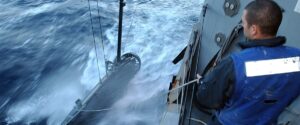
A RMMV mine-hunting drone is launched from the destroyer USS Bainbridge
Going back further, “RMS was initially designed to go on the Spruance class (destroyer), so that the battle group wound have a mine hunting capability that would allow the battle group to ‘punch through’ a minefield,” said retired minesweeper captain Robert O’Donnell. That may sound good, but, he said, “nobody ever defined what ‘punch through’ meant.”
The problem is both operational and cultural.
Navy culture makes it all too easy for surface commanders to ignore mine warfare unless that is their vessel’s only mission. And hunting mines is a slow, laborious task that requires a ship to stay in one small area until it’s done. That’s anathema to commanders of fast, multi-purpose warships that have many places to go and missions to do.
It make sense to distribute Mine Counter-Measures (MCM), more broadly, said retired Navy commander Bryan Clark, “but adding MCM to the task list of ships that are already unable to stay proficient and certified in their current mission areas is not a good idea.” (This summer’s deadly collisions involving two 7th Fleet ships is at least partly due to overworked units taking shortcuts on training). Instead, as Clark and his Center for Strategic & Budgetary Assessments recommended in a congressionally chartered study, the Navy should study adding mine warfare capabilities to unarmed auxiliaries like the huge Expeditionary Sea Base (ESB), the small EPF fast transport, and the midsized T-AKE cargo ship. After that, if you want to look at warships, Clark told me, then amphibious ships — with their cargo capacity, welldecks, and close-to-shore missions — are a better fit than destroyers.
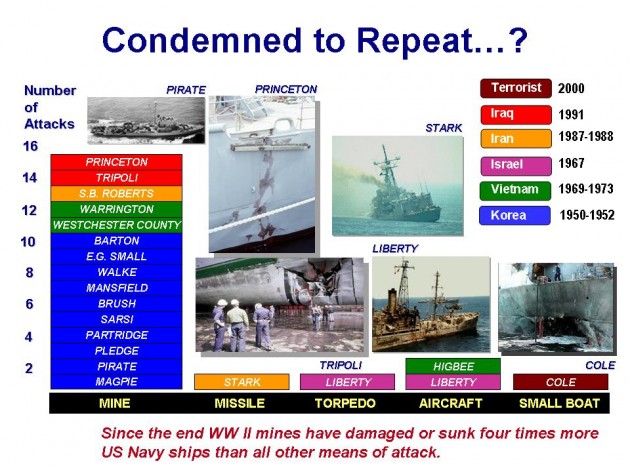
Mines have damaged or destroyed 15 US Navy vessels since World War II, more than all other causes combined. (Image courtesy Scott Truver).
“I agree…we don’t want to tie up a billion-dollar warship doing MCM operations,” said one of the authors of the new concept, Capt. Hans Lynch, who heads the mine warfare division on the Navy staff. That’s why the Navy has studied the Expeditionary Sea Base in the most detail and will try adding mine warfare capabilities to ESB first.
But the Navy will only buy five ESB and ESD-class ships, and it has only 30 amphibious ships of all classes, compared to 63 Arleigh Burke-class destroyers already in service. If you want to distribute widely, you can’t ignore destroyers.
And, Lynch went on, what if there’s a minefield between a warship and where it needs to go? Or what if the mines are part of a larger defensive system, with the minefield covered by enemy aircraft or anti-ship cruise missiles, which dedicated minesweepers lack the defenses to approach?
“In some cases, in many places in the world, in major combat operations, clearing those mines might be a prerequisite for the DDG doing its mission. So in that case putting MCM capability on board makes a lot of sense,” Lynch told me after his talk at the annual Expeditionary Warfare conference here. “(And) there’ll be a lot of situations where we want to operate in major combat operations where that might be the only platform that’s available to conduct that mission.”
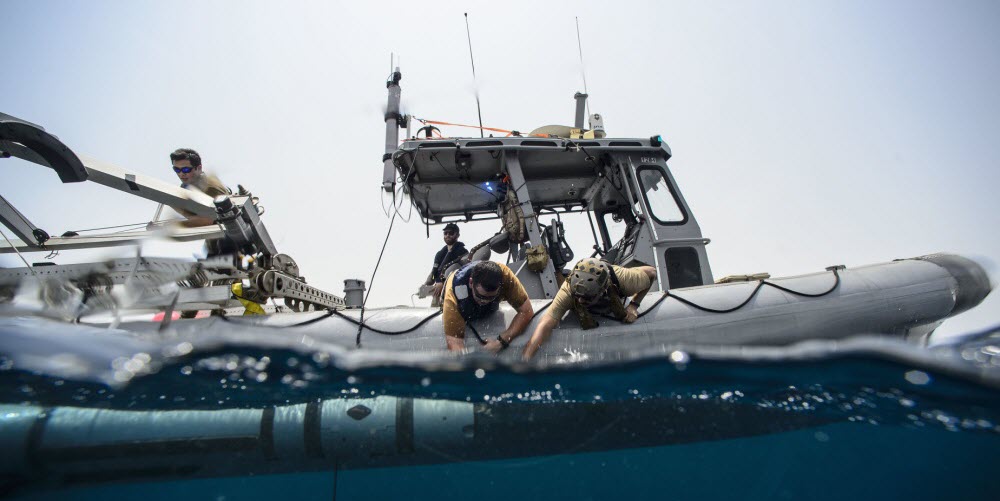
A Navy Expeditionary Mine Counter-Measures (ExMCM) team launches a Mk 18 unmanned underwater vehicle from their 11-meter inflatable boat in the Red Sea.
Innovation in the Mideast
The ugly truth is, as Breaking D readers know all too well, the US Navy has long neglected the unglamorous and deadly work of clearing mines, even though, since 1945, mines have sunk almost four times more US ships than all other threats combined. Top-level attention has waxed and waned, with the last two Chiefs of Naval Operations, Jonathan Greenert and John Richardson, unusually focused on mine warfare because of Iranian threats to “close” the Strait of Hormuz.
The current push to “distribute” Mine Counter-Measures (MCM) to a wider variety of ships is driven by the realization that there just aren’t enough dedicated minesweepers to do the job. The Navy’s now down to 11 aging Avenger-class minesweepers, which will be replaced by just eight MCM-equipped Littoral Combat Ships (LCS). (The much smaller Royal Navy, by contrast, has 15 minesweepers: seven Sandowns and eight Hunts).
So it’s not surprising the Navy wants to put some form of mine-countermeasures — not necessarily the full suite from an Avenger or LCS — onto other ships. The leading candidates are two auxiliary ships with lots of cargo space that can be reconfigured for MCM: the carrier-sized Expeditionary Support Base (ESB, formerly MLP) and the much smaller and faster Expeditionary Fast Transport (EPF, formerly JHSV). But the Navy is already considering putting counter-mine equipment on combat ships — amphibious ships, destroyers, even carriers — and that gets much more complicated.
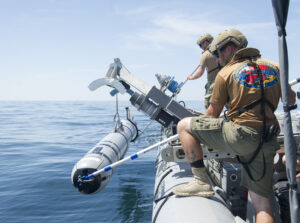
Mine warfare specialists deploy an Unmanned Underwater Vehicle (UUV) from the side of a small boat.
It’s certainly physically possible to deploy unmanned boats (USVs) and mini-subs (UUVs) from the deck of a warship. The Brainbridge did it a decade ago, and in recent years, Bahrain-based 5th fleet has done so as well.
“We don’t have to wait for LCS MCM mission package,” said Capt. Michael Egan, who commands the allied mine-hunting task force in the Persian Gulf (TF 52). “I’m sure when LCS arrives it’s going to be great,” he told the conference, but “the UUVs we have, they work, we’re deploying them off of other platforms — not what they were meant to do — (including) the weather deck of a cruiser.”
In addition to regular minesweepers, various 5th Fleet ships and land bases host Expeditionary Mine Counter-Measures (ExMCM) units. These are trained Explosive Ordnance Disposal (EOD) divers who set forth in rigid-hulled inflatable boats to deploy various drones.
Perhaps with the RMMV debacle in mind, Lynch turned to Egan and asked about the reliability of the robot boat known as the MHU, Mine Hunting Unmanned Surface Vessel. They rushed the MHUs to the Gulf to meet an urgent need, Lynch noted, so they didn’t go through the full panoply of testing.
They’re fine, Egan replied: “If things get banged up a little bit, you can bend it back.” (Not what an equipment provider longs to hear from the operator in the field). 5th Fleet might have sent the drones out in weather they weren’t rated to handle, Egan allowed, but they found mechanics to fix them in Bahrain “for pennies on the dollar” compared to sending them back to the States.
That said, the non-traditional approaches have distinct limits, Egan acknowledged. The Expeditionary MCM companies have the drones to find mines, but very limited ability to destroy them — especially compared to a minesweeper or an MH-53E helicopter towing an “influence sweep system” that can set off mines over a wide area.

A Navy EOD diver drops from an MH-53E mine-hunting helicopter during exercises.
The Human Factor
The Navy’s 11 minesweepers are being replaced by Littoral Combat Ships, eight of which will be dedicated full-time to the mine warfare mission, although they can be reconfigured to hunt submarines or fast attack boats instead if needed. The 27 MH-53E mine warfare helicopters, however, are being replaced by smaller, multi-purpose MH-60S. That means mine warfare is going from the sole mission of a few squadrons to a secondary mission of many squadrons. Will this new structure spread key mine-hunting skills or just dilute them?
The readiness of mine warfare squadrons is at a peak, said Capt. Mark Leavitt, commander of the Navy’s MH-53E wing. It had suffered when Navy leadership decided to cut their funding and manpower in order to refocus on LCS, which then didn’t arrive on time, but in recent years readiness has been rebuilt. Morale is high, said Leavitt, with personnel “actively working to stay in the community because they love the mission,” so experienced mine hunters keep coming back to the wing rather than dispersing across the Navy. It’s not clear, however, what happens to that critical mass of skilled personnel when mine warfare becomes one more mission for multi-purpose MH-60S squadrons.
The minesweeper community shows what might happen to the mine warfare aviators, because it’s never been particularly tight. “In many cases you would only do one tour in MCM and then you would never come back to it.,” Lynch told me. “I was an MCM CO (commanding officer) back in 2008-2009 and that was my first experience in MCM; and really I’ve remained interested in the MCM community since then, but I’ve never served in the MCM community since” until his current job. That makes it hard to build expertise.
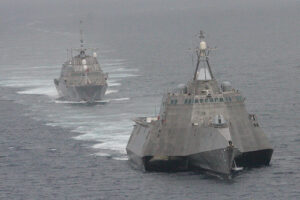
LCS-2, USS Independence, followed by LCS-1, USS Freedom, showing the two different designs.
“With LCS,” Lynch argued, “you can stay in the mainstream Navy on board an LCS and do multiple tours in MCM. MCM has a certain cachet to it that I think would attract people if…they weren’t committing career suicide.”
O’Donnell, the retired Navy captain with multiple tours on minesweepers, was skeptical. Even with an LCS “division” on each coast, he told me, there may not be enough institutional critical mass to produce excellence in mine warfare.
“Maintenance, training, tactics, procedures, doctrine, and requirements are split amongst many commands,” O’Donnell told me. “If the Navy’s going to distribute MCM throughout the fleet, this problem will probably get worse.”
“The No. 1 lesson-learned from the Navy’s miserable MCM performance during Operation Desert Storm” — when the USS Tripoli and Princeton both hit mines the same day — “was that there was no single command in charge of and responsible for providing trained and ready MCM Forces to the Fleet,” O’Donnell lamented. “It seems to me that we’ve reorganized to allow for this same failure again.”
Navy jet trainer fleet operations remain paused after engine mishap
One week after the incident, a Navy spokesperson says the service is continuing to assess the fleet’s ability to safely resume flight.


























